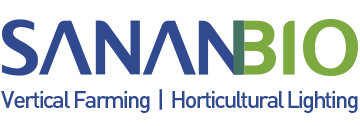Artificial sunlight——Why we choose LED grow lights for indoor farms?
It used to be incandescent light bulbs, HIDs, metal halides, and florescents dominating vertical farms, then LED became an option and has then been widely endorsed by researchers and vertical farm growers.
Why LED grow lights?
Energy efficient. In the horticultural sector, the density of fixture needs to be hyped up as compared with lighting in home or office scenarios. This rings true especially when it comes to feeding light-intensive crops, e.g., cannabis, rice and corn. The power required per square meter may fall between 500-1,000W. So efficacy can’t be too important. As of today, the efficacy of LED is 20 times better than incandescent, 3 times florescent, and 2 times HPS. Growers that choose LED to feed their plants see a reduction in the electricity bill.
A wider spectrum: 200-950nm. Full spectrum or monochromatic spectrum can be obtained relatively easier. This means that LED creates edges for researches in photosynthesis and studies on light recipes.
Adjustable intensity and spectrum. LED is a current-driven light source. The greater the current is, the brighter it gets. Thus, we control the luminance (brightness) by adjusting the current. We adjust the current for chips that feature certain wavelengths, we control the spectrum. At present, LED grow lights that are subject to spectrum tuning are mainly for researches, but we are seeing lots of grow lights that are subject to intensity adjustment in application.
A cold light source. LED dissipates less heat than any of its counterparts mentioned above. Thus, low power LED lights can be placed closer to the plants without growers fearing that burning can be caused to the plants or human body. That is also why growers endorse LED lights in their vertical farms.
A longer lifetime. Theoretically, LED’s lifetime is over 100,000 hours. A LED grow light, on the other hand, exceeds 50,000 hours as its lifetime when its working temperature is reasonably controlled. As of now, high-quality LED grow lights can have 5 years as warranty and its lumen depreciation can be less than 10% after working 36,000 hours. Florescent lights, however, sees a 30% of lumen depreciation after working 10,000-15,000 hours.
High controllability. LED is quick to response and operates normally when subject to quick switches of 3,000 times/second. HPS, on the other hand, stabilizes itself 5 minutes after switching on, and can only be re-powered on 10 minutes after being powered off.
Safe and transportation-friendly. Unlike glass-coated lights that break easily when being transported, LED is resilient to vibration, drop, and shock.
Chameleon-like shaping. Unlike light bulbs that need reflectors to help direct and focus lights down to the plants, LED can come as a top light that directs its photons straight down to the canopy, or as an inter-light that shines all-round at 360°. When encapsulated, LED chips emits the lights at 180°. That means LED lights with narrowed beam angles can be designed and manufactured more easily. It can go to the market as a top light (SANANBIO Hawk), or a panel light (SANNABIO PHX) that features high PPFD uniformity when mounted up-closely to the canopy.








